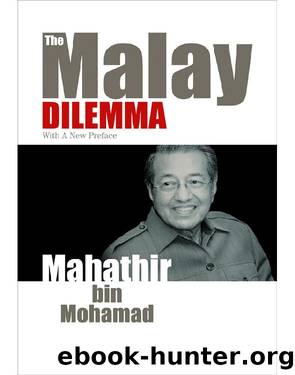The Malay Dilemma by Mahathir Mohamed

Author:Mahathir Mohamed [Mohamed, Mahathir]
Language: eng
Format: mobi
ISBN: 9789814382823
Publisher: Marshall Cavendish
Published: 2012-06-30T16:00:00+00:00
06
The Bases of National Unity
NATIONAL UNITY, like most political terms, is interpreted differently by different people. Like justice, it is a universal concept. It cannot be uniquely interpreted by or for one community alone. It must have certain values which are common although variations are permissible under differing circumstances.
Today there is a Department of National Unity in Malaysia. This is a measure of the recognition that national unity has gained not only in the eyes of the National Operations Council Government but also of right-thinking people in Malaysia.
The basis of national unity, simply stated, is a single ethnic group possessing a common language, culture and religion confined within an area of definite geographical boundaries. All these factors when present together have never failed to create a nation in the old sense of the word.
In the days when communication was poor and travelling minimal, nations were merely extensions of tribal organizations which, in turn, were extensions of combined or extended families. The limiting factor was geographical barriers, be it distance, mountains, the sea or rivers. Within a defined area, tribes came together in peace or war through the development of a common language, culture and religion, and fused to become a nation.
The sense of loyalty and unity within a nation was brought about by the ability to understand a common language, culture and religion. When other racial groups with differing cultures etc. came in contact with a given group the inability to understand each other led to conflict. In armed conflict a keener sense of kinship was felt within each group which led to a stronger sense of national unity.
In modern times, the United States of America became a great experiment in nation-building. When the thirteen colonies gained independence, they proved that kings were not important in uniting people. After gaining independence, the settlers of Anglo-Saxon stock began admitting immigrants of different ethnic and racial stocks with different religions, cultures and languages. The question was whether the adoption and not the inheritance of a common language and culture could create loyalty to a given legal state. The United States is of course a legal state, not a natural state with natural geographical barriers as boundaries.
During the period of intensive immigration to the United States in the nineteenth and early twentieth centuries, the new nation was severely tested. New immigrants ranged from Chinese to Russians. Practically every ethnic and language group was included. Knowledge of English, the official language among immigrants, was minimal or nil, as was knowledge of the culture and historical background of the United States. Religions were equally diverse. Out of this polyglot mixture of people, national unity was built primarily on a basis of language. The thirteen colonies were settled by people who spoke English, and they and their descendants were the core of the nation. Here an important principle was established and upheldâimmigrants wishing to be nationals had to learn English as the national language and its acceptance had to be complete, and the language actually spoken in everyday life.
Download
This site does not store any files on its server. We only index and link to content provided by other sites. Please contact the content providers to delete copyright contents if any and email us, we'll remove relevant links or contents immediately.
| Africa | Americas |
| Arctic & Antarctica | Asia |
| Australia & Oceania | Europe |
| Middle East | Russia |
| United States | World |
| Ancient Civilizations | Military |
| Historical Study & Educational Resources |
The Third Pole by Mark Synnott(915)
Money for Nothing by Thomas Levenson(898)
The Economist (20210109) by calibre(897)
Christian Ethics by Wilkens Steve;(824)
Made in China by Anna Qu(813)
The Age of Louis XIV: The Story of Civilization by Will Durant(791)
Reopening Muslim Minds by Mustafa Akyol(768)
Nonstate Warfare by Stephen Biddle(767)
100 Posters That Changed The World by Salter Colin T.;(751)
Culture by Terry Eagleton(724)
The Shortest History of China by Linda Jaivin(723)
The Great Pyramid Void Enigma by Scott Creighton(721)
The Irish Buddhist by Alicia Turner(720)
Ideology by Eagleton Terry;(696)
Routledge Handbook of Contemporary India by Knut A. Jacobsen(695)
Sybille Bedford by Selina Hastings(656)
The Jews of Silence: A Personal Report on Soviet Jewry by Elie Wiesel(651)
Objects of Vision by Saab A. Joan;(639)
Banaras: CITY OF LIGHT by Diana L. Eck(631)
